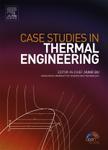版权所有:内蒙古大学图书馆 技术提供:维普资讯• 智图
内蒙古自治区呼和浩特市赛罕区大学西街235号 邮编: 010021

作者机构:Univ Hail Coll Pharm Dept Pharmaceut Chem Hail 55473 Saudi Arabia Univ Hail Med & Diagnost Res Ctr Hail 55473 Saudi Arabia
出 版 物:《CASE STUDIES IN THERMAL ENGINEERING》 (Case Stud. Therm. Eng.)
年 卷 期:2025年第70卷
核心收录:
基 金:Research Development and Innovation Authority (RDIA) -Kingdom of Saudi Arabia [12816-hu-2023-UH-R-2-1-HW]
主 题:MWCNT SiC Thermal conductivity Specific heat Magnetic field
摘 要:In this study, we investigated the thermal conductivity characteristics of MWCNT, cobaltencapsulated MWCNT (Co@MWCNT), and hybrid Co@MWCNT/SiC nanofluids, focusing on their thermal conductivity coefficients and specific heat under varying temperature and volume fraction conditions. The cobalt nanoparticles encapsulated in carbon nanotubes were synthesized using chemical methods and characterized through TEM, XRD, and FTIR techniques. The results indicate that cobalt nanocrystals are successfully encapsulated within carbon nanotubes, and SiC nanoparticles exhibit strong interactions with them. Notably, the hybrid composites can produce stable nanofluids with magnetic properties. The thermal conductivity coefficient is influenced by the pH of the solution, with optimal values typically found between pH 6 and 8 due to enhanced nanoparticle dispersion and reduced agglomeration in this range. As the concentration of cobalt and SiC nanoparticles increases, the thermal conductivity follows the trend of hybrid composites Co@MWCNT MWCNT. For instance, a 0.01 % increase in the volume fraction of hybrid nanoparticles can lead to a thermal capacity increase of up to 33 % compared to the base fluid. Moreover, applying a magnetic field of 0.05T can alter the thermal conductivity coefficient by enhancing the magnetic order of the cobalt atoms, often resulting in a 50 % increase in thermal capacity. Overall, the specific heat of these nanofluids varies with temperature and volume fractions, demonstrating a strong dependence on these factors. This study enhances the understanding of hybrid nanofluid properties and lays the groundwork for their practical applications in thermal management and energy systems.